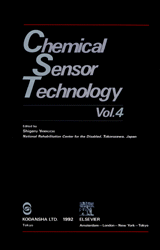Chemical Sensor Technology, Vol. 4
- タイトル読み
- 著者ほか
- 山内繁・編
- 著者ほか読み
- ヤマウチシゲル
- シリーズ:
- 英文書シリーズ

- 発行
- 1992
- サイズ
- B5変型
- ページ数
- 288
- ISBN
- 978-4-06-205458-4
- 定価
- 13,883円(税込)
- 在庫
- 在庫無し
内容紹介
<英文書>
ガスセンサ、バイオセンサ、イオンセンサなど化学センサの基礎、実用化、応用に関する最新の先導的研究を集録。国際的に精選された第一線の研究者が、新技術の展開のみならず研究思想や方法論にも言及。信頼性の高い情報を提供する最新のシリーズ第4巻。海外提携先:Elsevier B.V.
目次
Development of the TGS Gas Sensor
1. Introduction
2. Invention of the Gas Sensor
3. Establishment of Figaro Engineering Inc.
Some Basic Aspects of Semiconductor Gas Sensors
1. Introduction
2. Microstructure of SnO2 Particles
3. Influence of Microstructure on Gas Sensitivity
4. Modifications of SnO2 Surface
5. Concluding Remarks
Silicon Technologies for Sensor Fabrication
1. Introduction
2. Basic Processing Steps
3. Silicon on Insulator Technology
4. Silicon Micromechanics
5. Thin Film Chemical Sensors on Silicon Substrates
6. Chemical Sensors Based on Silicon Devices
7. Micromachined Chemical Sensors
8. Conclusion
Characterization of Oxygen Adsorbates on Semiconductive Oxides
1. Introduction
2. Oxygen Species Adsorbed on Oxides
3. Adsorption States of Oxygen Species on Oxides
4. Reactivity of Oxygen Species Adsorbed on Metal Oxides
5. Conclusions
Miniaturization of Catalytic Combustion Sensors
1. Introduction
2. Conventional Catalytic Combustion Sensors
3. Improvement for Selective CO Detection
4. Development of Low-power Sensors
5. Conclusion
Solid Electrolyte Potentiometric Oxygen Gas Sensors
1. Introduction
2. Operating Principles
3. Precision of Oxygen Partial Pressure Determination
4. Accuracy and Reliability
5. Response Time
6. Materials
7. Conclusions
NASICON: a Sensitive Membrane for Ion Analysis
1. Introduction
2. Structure and Properties of NASICON
3. NASICON Preparation Processes
4. ISE Improvements with NASICON
5. Conclusion
Characterization of Poly(dimethyldiallylammonium chloride) and Its Application to Electrochemical Sensors
1. Introduction
2. NMR Studies of Irradiated DMDAAC
3. Electrochemistry of Poly(DMDAAC) Networks on Platinum and Graphite
4. Solid-state Electrochemical Measurements Using Poly(DMDAAC)
5. Humidity Sensor
6. Conclusions
Biosensors with Microvolume Reaction Chambers
1. Introduction
2. LAPS Devices
3. Kinetics of pH change in Microvolumes
4. Application to Enzyme-linked Immunoassays
5. The Measurement of the Metabolism of Living Cells
6. Conclusion
Enzyme Sensor Utilizing an Immobilized Mediator
1. Introduction
2. The Use of Conducting Support
3. The Use of Water-soluble Macromolecular Mediators
4. Future Prospects
Piezoelectric Biosensors
1. Introduction
2. Principles of Piezoelectric Acoustic Sensors
3. Bioactive Surfaces
4. Experimental Piezoelectric Biosensors
5. Future Trends
Sensitization of Dielectric Surfaces by Chemical Grafting Application to ISFETs and ENFETs
1. Introduction
2. Chemical Sensitization of ISFETs
3. Surface Silanization of Silica Thin Layer
4. Conclusion
High Sensitive Immunosensor Employing Surface Photovoltage Technique
1. Introduction
2. Surface Photovoltage (SPV) Technique
3. Experimental Details
4. Experimental Results
5. Discussion
6. Conclusion
Non-invasive Monitoring of Glucose in Blood
1. Introduction
2. Suction Effusion Fluid as a Bio-chemical Constituent Sensing Sample
3. ISFET Biosensor for Body Fluid
4. Feasibility Study by Animal Experiments
5. SEF Technology Applied to Humans
6. Conclusion
Biosensing System for Odor Compounds Using Plants
1. Introduction
2. Biosensor and Biosensing
3. Strategy for the Development of an Odor-sensing System Using Plants
4. Response Properties of Plant Leaf to CO2 Gas
5. Mechanism and Significance of Leaf Responsiveness to High Concentrations of CO2 Gas
6. Responsive Properties of Plant Leaf to Odor Compounds
7. Quantitative Experiments on Odor Compounds
8. Concluding Remarks